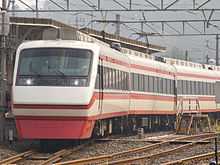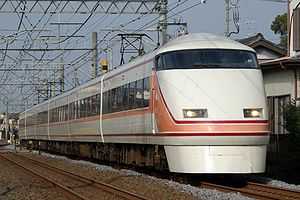Tobu 200 series
| Tobu 200 series | |
|---|---|
 200 series, June 2008 | |
| In service | since 1991 |
| Replaced | 1800 series |
| Constructed | 1990–1998 |
| Number in service | 60 vehicles (10 sets) |
| Formation | 6 cars per trainset |
| Operator | Tobu Railway |
| Depot(s) | Tatebayashi |
| Line(s) served | Tobu Skytree Line, Tobu Isesaki Line |
| Specifications | |
| Car length | 20 m |
| Doors | One per side |
| Maximum speed | 110 km/h (70 mph)[1] |
| Electric system(s) | 1,500 V DC |
| Current collection method | Overhead line |
| Track gauge | 1,067 mm (3 ft 6 in) |
The Tobu 200 series and 250 series (東武200系・250系 Tōbu 200/250-kei) are electric multiple unit (EMU) train types operated in Japan on limited express services by the private railway operator Tobu Railway since 1991.[2] The trains are used on Ryōmō services from Asakusa in Tokyo to Akagi and Kuzū.[3]
Formations
As of 1 April 2012, the fleet consists of nine 6-car 200 series sets and one 6-car 250 series set.[4]
200 series sets 201 to 209
| Car No. | 1 | 2 | 3 | 4 | 5 | 6 |
|---|---|---|---|---|---|---|
| Designation | Mc2 | M4 | M3 | M2 | M1 | Mc1 |
| Numbering | 200-6 | 200-5 | 200-4 | 200-3 | 200-2 | 200-1 |
Cars 2, 4, and 5 are each fitted with a pantograph (scissors type on sets 201 to 206, and single-arm type on sets 207 to 209.[4]
250 series set 251

| Car No. | 1 | 2 | 3 | 4 | 5 | 6 |
|---|---|---|---|---|---|---|
| Designation | Tc2 | M3 | T | M2 | M1 | Tc1 |
| Numbering | 251-6 | 251-5 | 251-4 | 251-3 | 251-2 | 251-1 |
Car 2 is fitted with one single-arm pantograph, and car 4 is fitted with two single-arm pantograph.[4]
Interior
Passenger accommodation is monoclass with unidirectional reclining seats arranged with a seat pitch of 985 mm (38.8 in). Vending machines selling drinks are provided.[1]
-

Interior view
-

Reclining seats
History
The first seven 200 series sets were built between 1991 and 1996 utilizing the bogies and traction motors from former 1700/1720 series "DRC" EMUs displaced by the arrival of new Spacia 100 series EMUs. The trains entered service from 1 February 1991.[5] Sets 208 and 209 built in fiscal 1997 featured HID headlights, LED destination indicators, and single-arm pantographs. 250 series set 251, was an entirely new build, delivered in March 1998. This featured the same 190 kW traction motors and bogies as the 30000 series, with VVVF control. Only three of the six cars in this set are motored.[5]
References
- ↑ 1.0 1.1 日本と世界の鉄道カタログ [Japan and World Railway Catalogue]. Japan: Seibido Publishing. August 1991. ISBN 4-415-03383-0.
- ↑ 私鉄車両年鑑2012 [Japan Private Railways Annual 2012]. Tokyo, Japan: Ikaros Publications Ltd. February 2012. p. 163. ISBN 978-4-86320-549-9.
- ↑ 日本と世界の鉄道カタログ [Japan and World Railway Catalogue]. Japan: Seibido Publishing. July 1992. ISBN 4-415-03262-1.
- ↑ 4.0 4.1 4.2 私鉄車両編成表 2012 [Private Railway Rolling Stock Formations - 2012]. Japan: JRR. July 2012. p. 45. ISBN 978-4-330-29911-2.
- ↑ 5.0 5.1 "2006東武鉄道優等車両カタログ" [2006 Tobu Railway Express Rolling Stock Catalogue]. Tetsudō Daiya Jōhō Magazine (Japan: Kōtsū Shimbun) 35 (264): p.22–24. April 2006.
External links
| Wikimedia Commons has media related to Tobu 200 series. |
- Tobu 200 series information (Japanese)
| |||||||||||||
